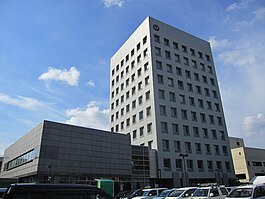Hachinohe
Hachinohe
八戸市 | |
|---|---|
 Hachinohe City Hall | |
 Hachinohe in Aomori Prefecture | |
| Country | |
| Region | Tōhoku |
| Prefecture | |
| Government | |
| • Mayor | Yūichi Kumagai |
| Area | |
| • Total | 305.6 km2 (118.0 sq mi) |
| Population (October 1, 2020) | |
| • Total | 223,415 |
| • Density | 731.1/km2 (1,894/sq mi) |
| Time zone | UTC+09:00 (JST) |
| Postal code | 031-8686 |
| Area code | 02203-9 |
| Phone number | 0178-43-2111 |
| Address | 1-1-1 Uchimaru, Hachinohe-shi, Aomori-ken |
| Website | Official website |
Hachinohe (八戸市, Hachinohe-shi) is a city in Aomori Prefecture, Japan.
Hachinohe means "the 8th area" in north of Tohoku region from the Middle Ages era. There was "the places of 8th" for making horses for a war in Hachinohe.
Hachinohe has a famous industrial area, and has a bigger fishing port more than most of other cities.
There is a Tohoku Shinkansen station and the Tohoku Expressway in Hachinohe.
The main industries in Hachinohe are manufacturing and services. Most of people in Hacnihohe work in manufacturing. In Hachinohe, the fishing industry is famous. Hachinohe brings in the most squid and saba in Japan.
Geography[change | change source]
Two rivers run through Hachinohe. One is the Mabechi River, which runs from the south to the east, and flows into the Pacific Ocean. The other is the Nida River, which runs from the south to the north.
Surrounding municipalities[change | change source]
Demography[change | change source]
According to Japanese census data,[1]
| 1995 | 2000 | 2005 | 2010 | 2015 | 2020 |
|---|---|---|---|---|---|
| 249,358 | 248,608 | 244,700 | 237,615 | 231,257 | 223,415 |


